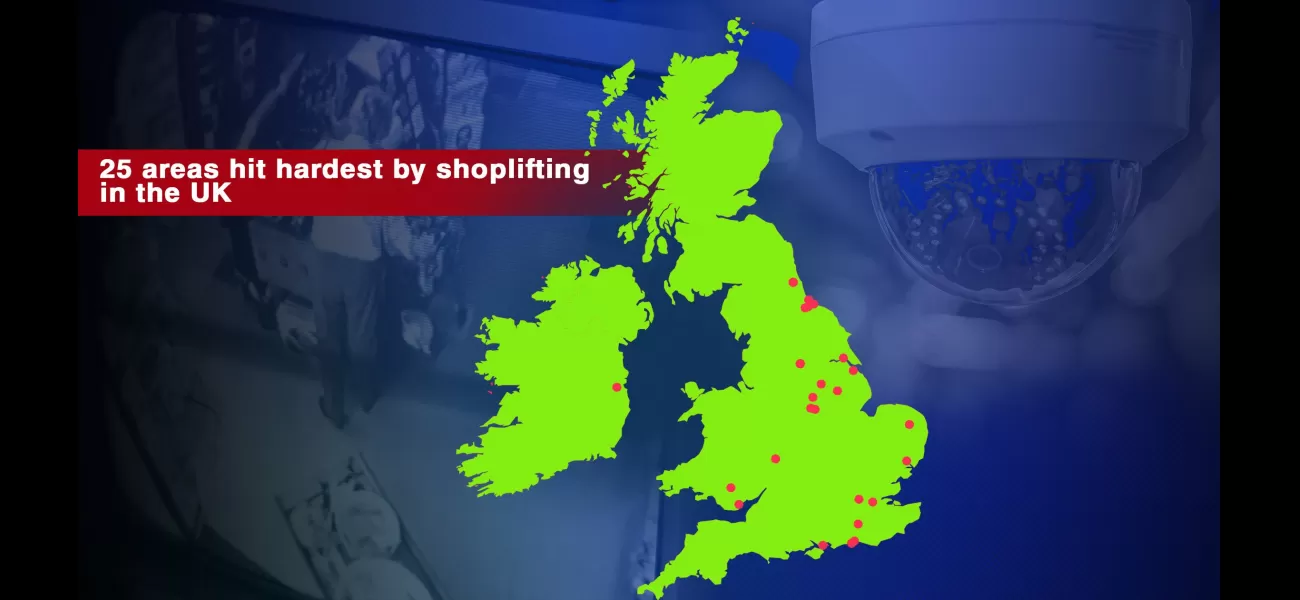Map shows areas of England and Wales with highest rates of shoplifting.
Retail crime is having a major effect on retailers, with warnings being issued about it.
September 24th 2023.

The North East has been revealed to be the worst affected region in terms of retail crime, according to new research. An analysis of the areas hardest hit by retail crime has shown that locations in the North East feature disproportionately in the top 25 municipalities.
Westminster is the single district with the highest number of reported thefts, with an average of 16.64 crimes per 1,000 head of population annually. This is unsurprising given the huge footfall of the district, which encompasses Oxford Street and the West End. Following Westminster, Lincoln comes second with 15.23 crimes per 1,000 head of population, and then Hartlepool, Worthing, Nottingham, Portsmouth, Adur, Mansfield, Dartford and Bassetlaw. Other North East regions including Middlesbrough, Redcar and Cleveland, Wakefield, Stockton-on-Tees, Newcastle and North East Lincolnshire also appear in the top 25.
The British Independent Retailers' Association (BIRA) has described the £2.8 billion loss from customer theft in the last financial year as 'the tip of the iceberg'. Retail crime has been blighting the high street, with opinion divided as to the reasons for the spike. It is worth noting that the North East regions are some of the most deprived in the UK, with Hartlepool ranking as the fifth most income-deprived local authority in England and Middlesbrough topping the list.
Cameron Jaques, business insurance expert at money.co.uk, traced a link between soaring levels of retail crime and the increases in household bills and prices at the tills. He suggested that the 'cost of living crisis' is forcing people to shoplift in order to afford essential everyday items.
Retailers may be driven out of business or towards Argo-style shopping models due to the tide of shoplifting, according to the British Retail Consortium. They have reported that retail crime incidents increased by 27% across 10 of the UK's largest cities in the 12 months to July 2023, and that violence and abuse towards workers has soared from around 455 incidents per day in 2019 to 2020 to more than 850 a day last year.
Iceland boss Richard Walker has spoken out of being physically attacked, including with weapons, by unwelcome visitors to their stores. Shopkeepers have also reported that thieves have been armed with hammers, knives and even hypodermic syringes as they target their branches.
It is clear that further action is needed to combat retail crime before the situation 'spirals out of control'. With the cost of living crisis here to stay, it is likely that supermarkets and retailers will have to deal with shoplifting as a regular occurrence.
A new map of England and Wales has revealed the areas hardest hit by retail crime, and the North East region has topped the list. Westminster is the single district with the highest number of reported thefts, with an average of 16.64 crimes per 1,000 head of population annually. Major cities such as Lincoln, Hartlepool, Worthing, Nottingham, Portsmouth, Adur, Mansfield, Dartford and Bassetlaw also feature in the top 25.
This follows research which showed a 27% increase in retail crime and a £2.8 billion loss from customer theft in the last financial year. The British Independent Retailers’ Association describes this as ‘the tip of the iceberg’. Retail crime has been blighting the high street and increasing levels of shoplifting, and the North East is also one of the most deprived regions in the UK. The Office of National Statistics data for 2019 shows that Hartlepool is the fifth most income-deprived local authority in England, with Middlesbrough topping the list.
Cameron Jaques, a business insurance expert at money.co.uk, believes there is a correlation between the cost of living crisis and shoplifting. He said: “The cost of living crisis is affecting us all. With the cost of food and basic necessities continuing to rise, it’s not surprising that shoplifting is on the rise as well as large segments of the UK’s population struggle to afford essential everyday items.”
Retailers may be driven out of business or towards Argo-style shopping models due to the tide of shoplifting, according to the British Independent Retailers’ Association. CEO Andrew Goodacre warns that more action is needed before the situation ‘spirals out of control’. He said: “If the tide of thefts is not contained we will see business owners close because losing stock is the same as losing cash. In convenience stores, the margins are too small to withstand the cost of stock losses at these levels. Other changes, and some of these have already happened, will be shops operating a closed-door policy by appointment only, replacing products on shelves with dummy products, investing in better CCTV and body cameras for staff and reduced hours. Ultimately, we may well see shops adopting the Argos model where stock is kept in a storeroom and people order items from a catalogue.”
Shopkeepers have also reported physical attacks, with some thieves using weapons such as hammers, knives and even hypodermic syringes. British Retail Consortium statistics show that retail crime incidents increased by 27%, and violence and abuse toward workers soared from around 455 incidents per day in 2019 to 2020 to more than 850 a day last year. This is just reported crime, and Andrew Goodacre believes the true figure is much higher. He said: “The recent research is just reported crimes so it is probably the tip of the iceberg.”
Westminster is the single district with the highest number of reported thefts, with an average of 16.64 crimes per 1,000 head of population annually. This is unsurprising given the huge footfall of the district, which encompasses Oxford Street and the West End. Following Westminster, Lincoln comes second with 15.23 crimes per 1,000 head of population, and then Hartlepool, Worthing, Nottingham, Portsmouth, Adur, Mansfield, Dartford and Bassetlaw. Other North East regions including Middlesbrough, Redcar and Cleveland, Wakefield, Stockton-on-Tees, Newcastle and North East Lincolnshire also appear in the top 25.
The British Independent Retailers' Association (BIRA) has described the £2.8 billion loss from customer theft in the last financial year as 'the tip of the iceberg'. Retail crime has been blighting the high street, with opinion divided as to the reasons for the spike. It is worth noting that the North East regions are some of the most deprived in the UK, with Hartlepool ranking as the fifth most income-deprived local authority in England and Middlesbrough topping the list.
Cameron Jaques, business insurance expert at money.co.uk, traced a link between soaring levels of retail crime and the increases in household bills and prices at the tills. He suggested that the 'cost of living crisis' is forcing people to shoplift in order to afford essential everyday items.
Retailers may be driven out of business or towards Argo-style shopping models due to the tide of shoplifting, according to the British Retail Consortium. They have reported that retail crime incidents increased by 27% across 10 of the UK's largest cities in the 12 months to July 2023, and that violence and abuse towards workers has soared from around 455 incidents per day in 2019 to 2020 to more than 850 a day last year.
Iceland boss Richard Walker has spoken out of being physically attacked, including with weapons, by unwelcome visitors to their stores. Shopkeepers have also reported that thieves have been armed with hammers, knives and even hypodermic syringes as they target their branches.
It is clear that further action is needed to combat retail crime before the situation 'spirals out of control'. With the cost of living crisis here to stay, it is likely that supermarkets and retailers will have to deal with shoplifting as a regular occurrence.
A new map of England and Wales has revealed the areas hardest hit by retail crime, and the North East region has topped the list. Westminster is the single district with the highest number of reported thefts, with an average of 16.64 crimes per 1,000 head of population annually. Major cities such as Lincoln, Hartlepool, Worthing, Nottingham, Portsmouth, Adur, Mansfield, Dartford and Bassetlaw also feature in the top 25.
This follows research which showed a 27% increase in retail crime and a £2.8 billion loss from customer theft in the last financial year. The British Independent Retailers’ Association describes this as ‘the tip of the iceberg’. Retail crime has been blighting the high street and increasing levels of shoplifting, and the North East is also one of the most deprived regions in the UK. The Office of National Statistics data for 2019 shows that Hartlepool is the fifth most income-deprived local authority in England, with Middlesbrough topping the list.
Cameron Jaques, a business insurance expert at money.co.uk, believes there is a correlation between the cost of living crisis and shoplifting. He said: “The cost of living crisis is affecting us all. With the cost of food and basic necessities continuing to rise, it’s not surprising that shoplifting is on the rise as well as large segments of the UK’s population struggle to afford essential everyday items.”
Retailers may be driven out of business or towards Argo-style shopping models due to the tide of shoplifting, according to the British Independent Retailers’ Association. CEO Andrew Goodacre warns that more action is needed before the situation ‘spirals out of control’. He said: “If the tide of thefts is not contained we will see business owners close because losing stock is the same as losing cash. In convenience stores, the margins are too small to withstand the cost of stock losses at these levels. Other changes, and some of these have already happened, will be shops operating a closed-door policy by appointment only, replacing products on shelves with dummy products, investing in better CCTV and body cameras for staff and reduced hours. Ultimately, we may well see shops adopting the Argos model where stock is kept in a storeroom and people order items from a catalogue.”
Shopkeepers have also reported physical attacks, with some thieves using weapons such as hammers, knives and even hypodermic syringes. British Retail Consortium statistics show that retail crime incidents increased by 27%, and violence and abuse toward workers soared from around 455 incidents per day in 2019 to 2020 to more than 850 a day last year. This is just reported crime, and Andrew Goodacre believes the true figure is much higher. He said: “The recent research is just reported crimes so it is probably the tip of the iceberg.”
[This article has been trending online recently and has been generated with AI. Your feed is customized.]
[Generative AI is experimental.]
0
0
Submit Comment





